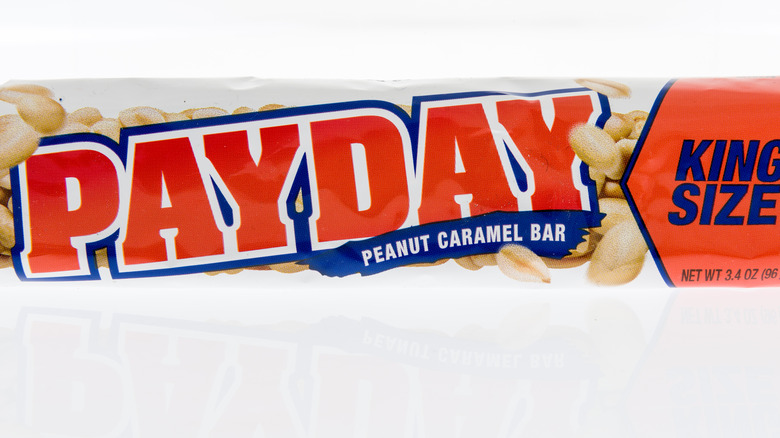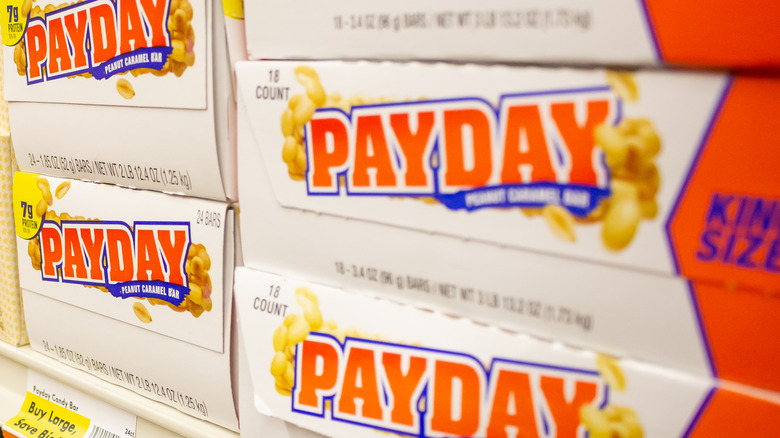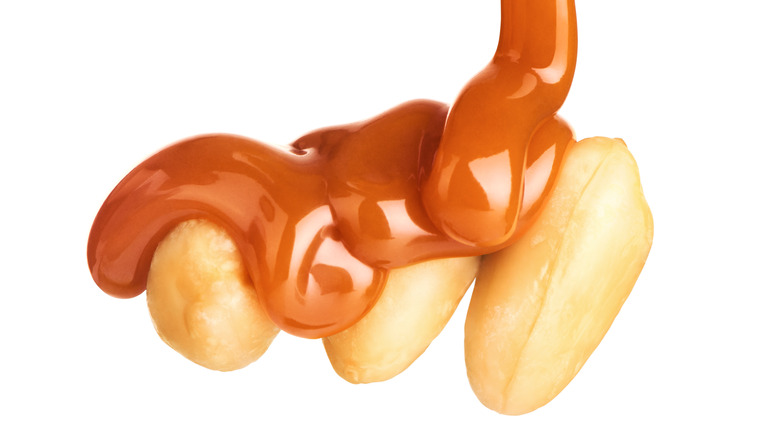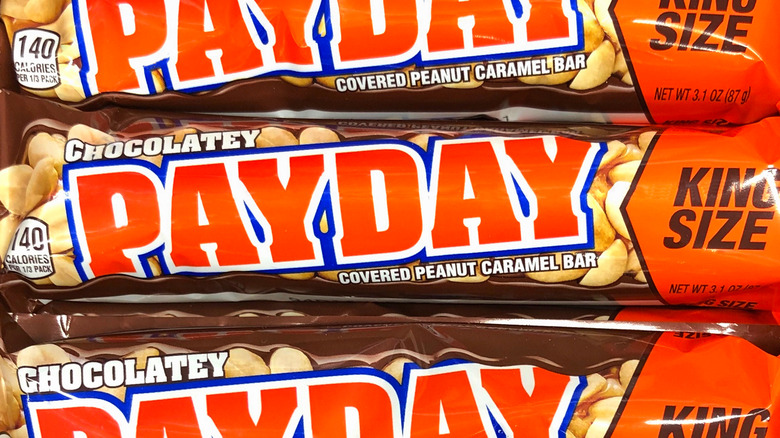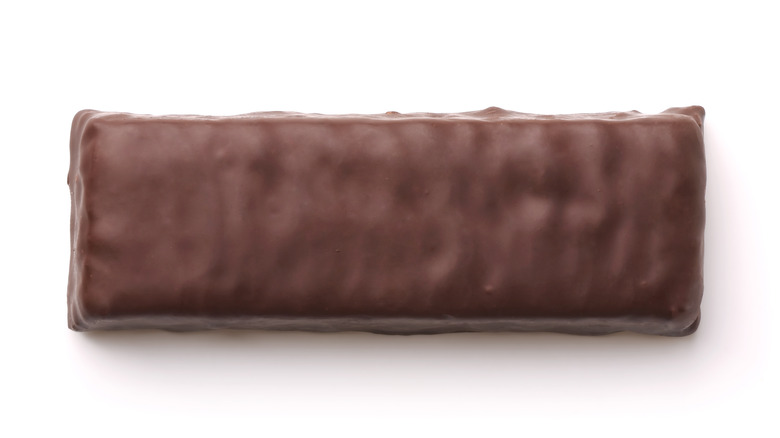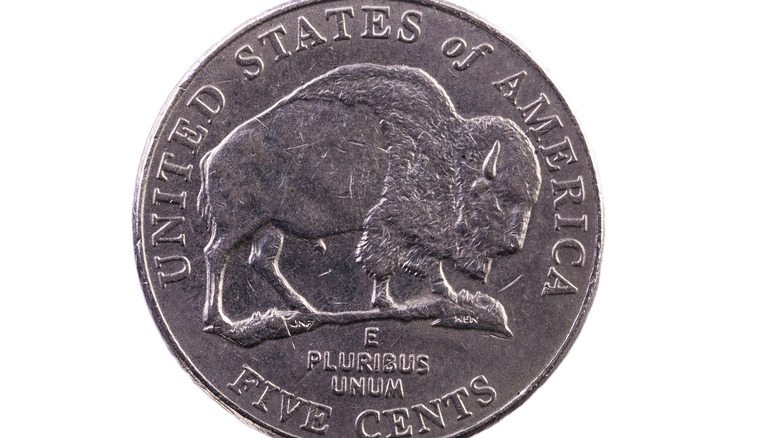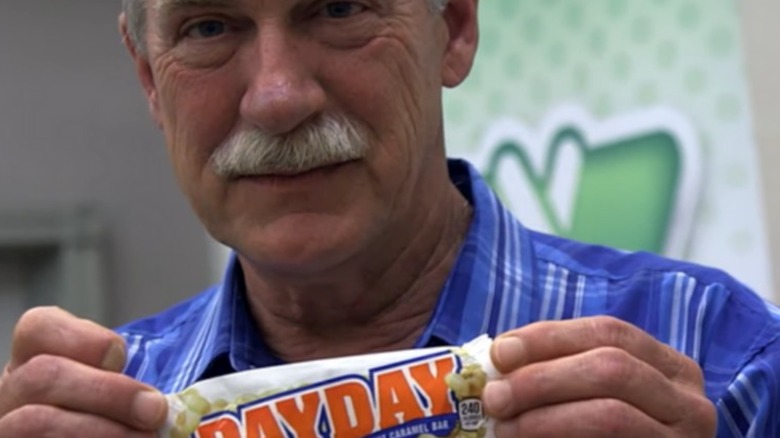The Untold Truth Of PayDay
If you think of all the different pairings in the world, sweet and salty has to be the most popular — peanut butter and jelly, chicken and waffles. Fruit and salt? That one might be up for debate. But perhaps this winning combination is what makes PayDay such an eternal confection. PayDay bars are one of those hotly debated sweet treats. There are diehard fans that live for this decadent log of rich caramel and peanutty goodness. Others just need a snack, and it's the first thing they reach for. And then there are those who think PayDay is just every other Friday.
After being on the market for almost 80 years, this candy bar is still a major player in the world of sweets, most likely because it has a legendary flavor profile, and some good history tied to it. But what exactly is PayDay? What isn't it? Let's demystify this simple treat and unwrap some hidden truths about a celebrated candy bar.
PayDay was actually named on a payday
It's true. When PayDay was brought into inception in 1932, its creators had no idea what to call it. After all, "Sweet and Salty Nut Log" doesn't really make you want to jump up and run to the store, does it? We can only imagine that during a lunch break, the marketing guys were scratching their heads trying to figure out a name that would appeal to all ages, when suddenly someone shouted, "PayDay!" and a legend was born.
Well, this scenario is partially true. You can't go wrong with peanuts and caramel — that's a fact. Creating a candy bar with these ingredients is like sitting on a potential goldmine. Some marketing person must have realized this back then. And while we don't know which Hollywood Brands employee suggested it, Old Time Candy reports that the name PayDay was literally proposed on a payday.
To be frank, in the days of the Great Depression, nobody was really getting paid anyway, so a payday that was definitely something to get excited about. Who wouldn't want a PayDay on a payday?
Many hands touched PayDay before Hershey's
Contrary to popular belief, Hershey's was not the creator of the PayDay bar. This sweet n' salty confection was actually the brainchild of Frank Martoccio, the founder of Hollywood Brands, also known as The Hollywood Candy Company. It was named after Martoccio's hometown: Hollywood, Minnesota. In 1938, he moved the company to Illinois and continued production of his beloved PayDay. Consolidated Foods (what we now know as Sara Lee) purchased Hollywood Brands from the Martoccio family in 1967.
13 years later, the Illinois plant was destroyed by a fire. Luckily, L.S. Heath & Sons (you know, Heath bars) jumped in to assist with PayDay production. Technically, without Heath Bars, PayDay would cease to exist. In 1988, The Hollywood Candy Company was yet again acquired by a different business, whose most well-known claim to fame are Astropops and Tart n' Tinys (both staples of the '80s and '90s): Leaf Candy Company. Finally, in 1996, Hershey's wanted in on PayDay, so to solve that issue, they purchased Leaf Candy Company. And that is the life story of PayDay (so far).
PayDay was originally marketed as a meal replacement bar
Using a candy bar as a meal replacement is probably not high on the list of great nutritional ideas. But back in its heyday, PayDay (try saying that five times fast) was actually marketed as such. Why? Because peanuts are high in calories, and ultimately more bang for your nickel. They're 25% protein, making them a great, inexpensive, and tasty fuel for your body. Per 3.5 ounces, peanuts contain a whopping 25.8 grams of protein, making up a little over half of an adult's daily protein requirements. While there isn't anywhere near this amount in a PayDay bar (it tops off at seven grams), it's also high in healthy fats. That's why it was marketed as a quick and efficient fuel. The rest of a PayDay bar consists of carbohydrates (your body's main source of energy) and sugar (that constant supply of energy to your noggin).
Keep in mind that in the early to mid 1900s, people counted calories a smidgen differently than they do today. They needed those calories for energy, so going over a 2,000 calorie diet wasn't a concern. This was a time when going to work more often meant hard, physical labor (factories, farming, and everything in between). Keeping yourself in a vertical position with all of your fingers, toes, and appendages was the main priority, alongside putting food on the table.
When this "nut bar" came on the market, America was in the midst of the Great Depression. Everything was scarce, but at five cents a pop, these were an economical and tasty way to get energy into your body with what little money you had.
PayDay also has a protein bar
For those of you who are still on the meal replacement bandwagon, Hershey's actually released a protein bar back in 2005 which they dubbed the PayDay Pro Bar. This is a slight variation on the old reliable, only with less sugar, carbs, and fat. For example, a normal PayDay has 240 calories, 7 grams of protein, 20 grams of sugar, 27 grams of carbs, and 13 grams of fat. A Pro Bar has 220 calories, 7 grams of protein, 15 grams of sugar, 21 grams of carbs, and 8 grams of fat. So if the standard peanuts & caramel nougat just don't do it for you, you can treat yourself to a Pro Bar with peanuts and chocolate (and caramel), peanuts and raisins, or peanuts and trail mix. These protein bars are comparable in almost every aspect, except that they have variations in flavor and are slightly less fattening than the OG PayDay.
Most likely due to line extension, it's a bit of a struggle to find Pro Bars in stores, or even online. Perhaps a candy company trying to market a health food item doesn't really work.
If you had a nickel for every time you bought a PayDay in 1989...
Back in 1989, as part of a well-crafted marketing campaign, 12.3 million lucky PayDay lovers unwrapped their tasty peanut-packed sugar snacks only to discover that tucked inside was a bright, shiny nickel. It was, of course, individually wrapped and not embedded directly into the candy itself. But why five cents and why 1989? The jury is still out on why 1989 was the year this promotion went live, but the five-cent piece hearkens back to a time when you could purchase a PayDay for — you guessed it — five cents.
Remember how PayDay was originally being marketed as a meal replacement bar during The Great Depression? Back then, five cents was a feasible amount to spend on something that could help sustain you or your family. You could also buy a cup of coffee, a glass bottle of coke, an ice cream cone, or a doughnut. Makes you wonder what people from that era would think of paying a dollar or more for these sugar bombs.
PayDay helped a man hit the jackpot
In 2016, an 80-year-old Virginian man named Mike Murphy had a sudden hankering for a candy bar, something that deviated far from his usual snacking habits. So he did what any down-to-earth, hungry citizen would do — he stopped by a mom n' pop convenience store (support local) and, on the advice of the cashier (there are so many candy bar options nowadays) he purchased a PayDay. His eye was also drawn to a bright and shiny Virginia $100 Million Cash Extravaganza lottery ticket. So with his spare change from the candy bar, he purchased one. As he happily noshed on his sweet, protein-packed treat, he scratched away at his lottery ticket.
His gut (and appetite) led him in the right direction that day, because he ended up winning $4 million. Murphy had the option to take the full lump sum over the next 30 years, but he opted for the one-time cash pay out of $2,724,000 instead.
